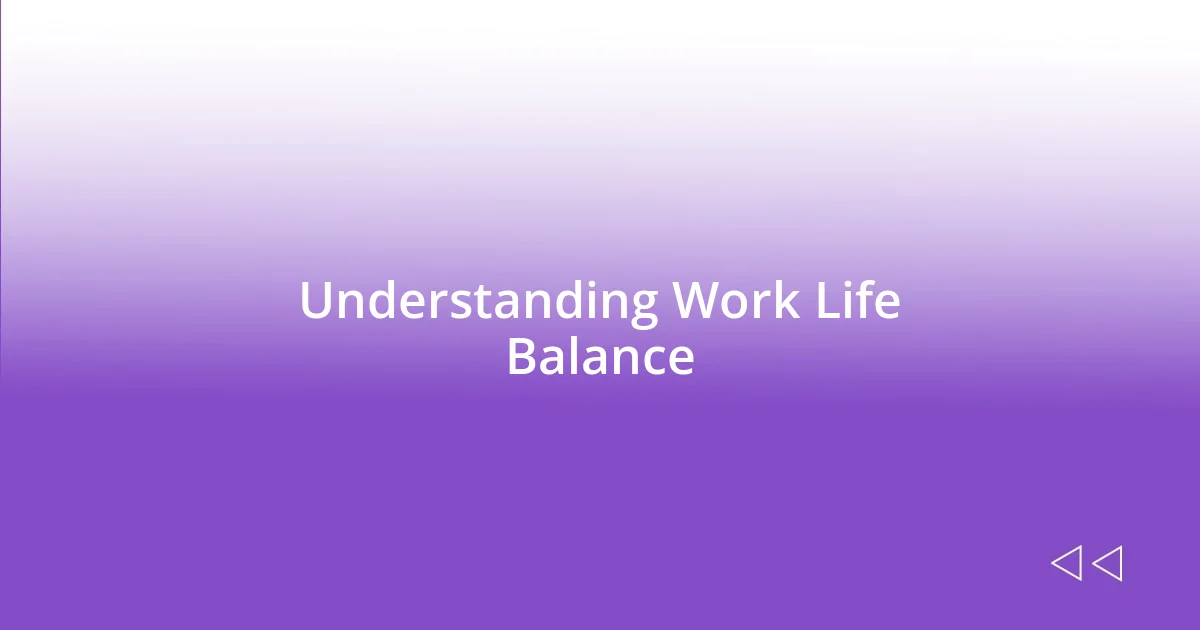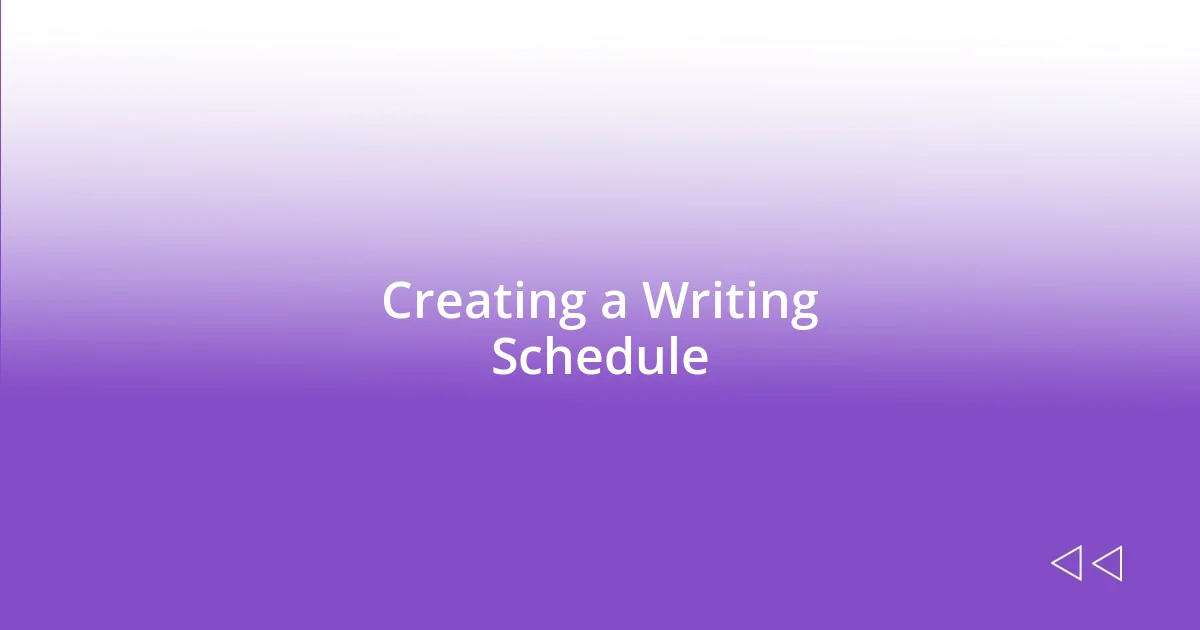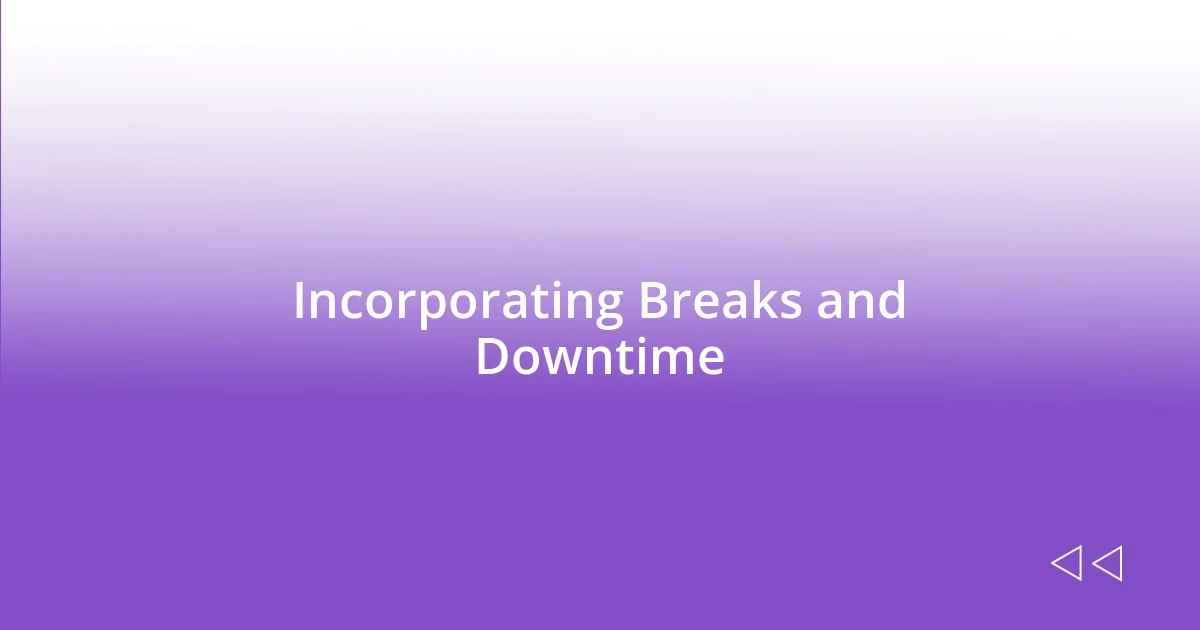Key takeaways:
- Maintaining work-life balance requires intentional boundary-setting and prioritization of personal relationships and creative time.
- Creating a flexible writing schedule that integrates personal commitments can enhance productivity and reduce stress.
- Incorporating regular breaks, utilizing productivity tools, and reflecting on progress are essential for nurturing creativity and improving writing quality.

Understanding Work Life Balance
Work-life balance is often more than just a buzzword; it’s a vital aspect of our well-being. I remember a time when I was caught up in an intense writing project. I noticed that my interactions with friends and family diminished, and it left me feeling isolated, questioning if my work was truly worth the sacrifice. Isn’t it interesting how our passion can sometimes overshadow the very relationships and experiences that bring us joy?
Finding that balance requires intentionality. I’ve learned to set boundaries for my writing time, allowing for dedicated moments where I disconnect completely. This practice not only rejuvenates my creativity but also deepens my connections with those I care about. Have you ever noticed how stepping away can provide fresh perspectives?
Ultimately, achieving a harmonious blend of work and personal life is a dynamic journey. I often reflect on the small joys that come from this balance—like cooking dinner with loved ones or taking a leisurely walk. Those moments breathe life into my writing, reminding me that personal experiences can provide the richest inspiration. How do you prioritize those essential moments in your own life?

Identifying Your Priorities Clearly
Identifying your priorities clearly is essential for maintaining balance in your writing and personal life. I can’t tell you how many times I’ve found myself overwhelmed, juggling multiple projects without a clear sense of what truly mattered. It took me some trial and error to realize that when I identified my primary goals—whether it was finishing a piece on a tight deadline or making time for a weekend family gathering—I could approach my tasks with renewed focus and energy.
To clarify your priorities, consider these actionable steps:
- List your top three personal and professional goals.
- Rank them in order of importance and time sensitivity.
- Assess how much time you can realistically dedicate to each goal.
- Review your weekly schedule and allocate specific time blocks for each priority.
- Reflect regularly to adjust as necessary—life changes, and so should your priorities.
I vividly recall a weekend where I prioritized a family outing over an impending article submission. At first, I felt a twinge of guilt, but the laughter and connection we shared became a source of inspiration for my writing later on. This experience reinforced the importance of knowing what truly matters at any given moment.

Creating a Writing Schedule
Creating a writing schedule can be a game-changer. Personally, I’ve found that setting aside specific time blocks for writing allows me to be more productive and focused. For instance, I wake up early before the world stirs and enjoy a quiet hour (or two) of uninterrupted writing. It’s amazing how much I can accomplish when I have a dedicated space free from distractions. Have you ever tried carving out a special time just for your writing?
Another approach that has worked for me is integrating my writing schedule with my personal commitments. I keep a shared calendar that outlines not just my writing sessions but also family times and social gatherings. This way, I avoid the stress of double booking myself and can honor my commitments. I recall a lovely Sunday afternoon when I synced my writing schedule with family activities—while I wrote in the morning, I knew I’d be free to join them for a picnic later. This blend made both my work and family time feel purposeful.
It’s crucial to remain flexible with your schedule as well. Life is unpredictable, right? I’d planned a whole week of late-night writing sessions, only to be pulled into various unexpected commitments. I’ve learned to adapt by shifting my writing time to early mornings instead. It’s all about finding what rhythm works for you and adjusting as needed. Your schedule should empower you, not constrain you. Have you had moments where adjusting your plans led to unexpected inspiration?
| Writing Schedule Approaches | Personal Insights |
|---|---|
| Dedicated Time Blocks | This approach helps maximize productivity. I can pour my creativity into focused sessions. The solitude is a breath of fresh air! |
| Integrated Schedules | Syncing writing and personal life keeps my commitments in check. It was a relief to enjoy a family picnic after completing my morning writing! |
| Flexible Adjustments | Adjusting my writing schedule based on life’s unpredictability brought unexpected creativity. Morning sessions allowed me to refresh my ideas during those busy weeks! |

Setting Boundaries for Writing
Setting boundaries for writing is crucial for nurturing both my creative spirit and personal relationships. I’ve come to realize that saying “no” to certain projects or distractions can be liberating. There was a time I accepted every request for articles, thinking I could manage it all. One day, I found myself typing away furiously while my kids played outside. It hit me—by not setting clear boundaries, I was missing precious moments. Have you ever felt torn between your passion and your loved ones?
Creating a physical space for writing also contributes significantly to these boundaries. I chose a cozy nook in my home, adorned with plants and good lighting, which signals to me and my family that when I’m here, I’m on a mission. It’s fascinating how simple cues can establish a productive mindset. Once, my daughter barged in with her favorite book, looking for my attention. Instead of feeling guilty, I reminded her that my writing time was important, but I promised to read to her right after. Haven’t you noticed how a designated space can help reinforce your writing discipline and enhance focus?
Additionally, I find it helpful to communicate my writing schedule with loved ones. Just recently, I shared my upcoming deadlines during a family dinner, which helped them understand when I’d be busy. This clarity not only minimized interruptions but also allowed them to support me better. By nurturing open communication, I create a collaborative atmosphere where everyone respects each other’s time and responsibilities. How do you establish boundaries to make your writing time respected? It’s all about practicing those boundaries until they become second nature!

Incorporating Breaks and Downtime
Taking regular breaks is essential for maintaining creativity and focus. I’ve learned that stepping away from my writing, even for just a few minutes, can spark new ideas and refresh my mind. For instance, when I’ve been stuck on a piece, a quick walk around my neighborhood often helps clear the mental fog. Have you ever noticed how a change of scenery can inspire you in unexpected ways?
Moreover, I’ve developed a habit of scheduling downtime after intense writing sessions. This downtime isn’t just about resting; it’s a moment for reflection and gratitude. I often treat myself to my favorite tea or do a few stretches to reconnect with my body and mind. I recall a particularly long writing day when I took that moment for pause and ended up jotting down a completely new idea that transformed my work. Isn’t it incredible how those small breaks can lead to significant breakthroughs?
Lastly, downtime isn’t strictly about silence or solitude; it can be social too. I prioritize time with friends and family, knowing that these interactions recharge my emotional batteries. Last month, I organized a game night, and the laughter and connection felt so rejuvenating. It reminded me that my inspiration often comes from life experiences shared with loved ones. How do you incorporate social breaks into your routine? Balancing time spent writing with time spent enjoying life enriches my creativity so much.

Utilizing Tools for Productivity
Utilizing productivity tools has been a transformative experience for me. For starters, I’ve embraced task management apps that allow me to prioritize my writing goals more effectively. There’s a certain satisfaction in checking off completed tasks, and I can’t help but feel a surge of motivation each time I do. Have you ever found that a simple checklist can turn daunting projects into manageable steps?
Time tracking tools have also become invaluable in my writing routine. I vividly recall a time when I underestimated how long a particular article would take. After logging my hours, I realized I was losing precious time to distractions. Armed with this information, I redirected my focus and adjusted my writing schedule accordingly. It’s fascinating how data can sharpen our productivity—it’s like having a personal coach guiding me through my writing journey.
Finally, I’ve discovered the power of creating a writing playlist filled with music that boosts my concentration. There are moments when a certain song can transport me into a creative zone. Recently, while drafting a challenging piece, I put on my favorite instrumental tracks, and before I knew it, the words flowed effortlessly. Isn’t it amazing how music can shape our writing atmosphere? By utilizing these tools, I’ve not only increased my productivity but also made the writing process far more enjoyable.

Reflecting and Adjusting Your Approach
Reflecting on my writing journey has been both enlightening and necessary. I often revisit old drafts, realizing how far I’ve come and what lessons I’ve learned. One particular moment stands out; after rereading a piece I wrote a year ago, I was astonished at my growth. How often do we take a moment to acknowledge our progress? This practice helps me adjust my approach and embrace new techniques that resonate with my evolving style.
Adjusting my writing process isn’t just about technique; it’s also about knowing when to pivot emotionally. I remember a time when I was pouring my heart into a personal essay, but it felt flat. Realizing I was disconnected from my topic made me step back and re-evaluate my thoughts. That moment of honesty led to a brainstorm session where I allowed my emotions to lead the way. Have you ever found that sitting with your feelings can bring clarity to your writing?
Sometimes, the adjustments I make involve seeking feedback from trusted peers. I cherish these conversations—they illuminate blind spots I may not see on my own. I vividly recall a friend’s insight that transformed a lackluster section of my work into something dynamic and engaging. Isn’t it incredible how collaboration can elevate your writing? I now integrate this feedback process regularly, ensuring my writing not only reflects my voice but also connects with my audience.














